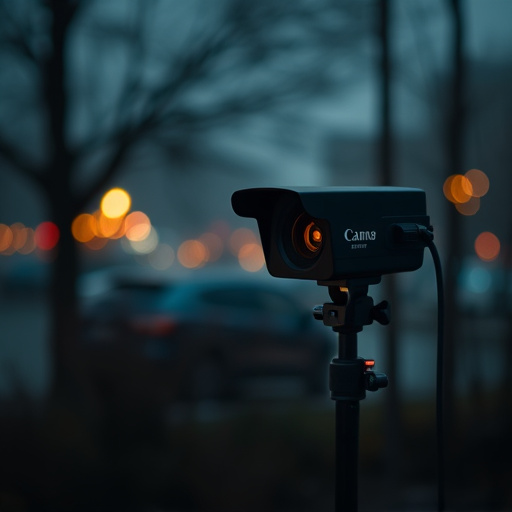Battery-powered covert nanny cameras rely on electromagnetic signals for their operation, making signal detection crucial for professionals to locate and counteract hidden surveillance. These signals span various frequencies, from high-band wireless communications to lower bands used by stealth cameras. By understanding the RF spectrum, employing direction-finding techniques, and staying updated on technology trends, experts can effectively detect these cameras, ensuring privacy and security in homes and offices while adhering to legal and ethical standards regarding their use.
“Uncover hidden threats with an in-depth guide to surveillance device electromagnetic signal detection. From understanding the fundamentals of electromagnetic signals to navigating legal boundaries, this article equips readers with essential knowledge for identifying covert battery-powered nanny cameras and similar devices.
We explore cutting-edge techniques for location, real-world application tips, and ethical considerations, ensuring you’re prepared in today’s tech-driven world.”
- Understanding Electromagnetic Signals: A Foundation for Detection
- Battery-Powered Covert Cameras: Unveiling the Technology
- Tips for Effective Signal Detection in Real-World Scenarios
- Advanced Techniques to Locate Hidden Devices
- Legal and Ethical Considerations: Navigating Privacy Laws
Understanding Electromagnetic Signals: A Foundation for Detection
Electromagnetic signals are an integral part of modern technology, often carried by devices like battery-powered covert nanny cameras. Understanding these signals is crucial for their effective detection. These signals can be categorized into various types, each with unique characteristics and frequencies. High-frequency signals, for instance, are commonly used in wireless communications and can be detected using specialized equipment that picks up on the subtle electromagnetic fluctuations they produce.
Knowing the specific frequency ranges of different devices is key to successful detection. Battery-powered cameras, often designed for covert operations, may operate in less congested frequency bands to avoid detection. This requires detector users to have a broad understanding of common signal frequencies used by such devices. By recognizing these patterns and adapting their detection methods accordingly, professionals can enhance their chances of locating hidden surveillance equipment, ensuring privacy and security in various settings.
Battery-Powered Covert Cameras: Unveiling the Technology
Battery-powered covert cameras, often referred to as nanny cams, have revolutionized surveillance technology. These tiny yet powerful devices are designed to operate discreetly, making them ideal for monitoring activities in homes, offices, or any private space without raising suspicion. The use of battery power allows these cameras to be placed in hard-to-reach areas, such as behind furniture or tucked away in corners, ensuring unobtrusive observation.
The technology behind battery-powered covert nanny cams involves compact and efficient hardware that consumes minimal energy while delivering high-quality video footage. They often come equipped with night vision capabilities, motion sensors, and remote access features, making it possible to monitor activities from a distance. With the advancement of wireless connectivity, these cameras can now be controlled and viewed through smartphone apps, further enhancing their covert operations and accessibility.
Tips for Effective Signal Detection in Real-World Scenarios
In real-world scenarios, effectively detecting electromagnetic signals from battery-powered covert nanny cameras requires a strategic approach. One crucial tip is to familiarize yourself with the radio frequency (RF) spectrum and common communication bands used by such devices. Many modern nannycams operate on ISM (Industrial, Scientific, and Medical) bands, such as 433 MHz or 915 MHz, which are less congested than cellular bands. Using RF detectors capable of scanning these specific frequencies is essential.
Another effective strategy involves employing direction-finding techniques to pinpoint the source of signals. By using multiple antennas and analyzing signal strengths in different directions, you can narrow down the location of the emitting device. Additionally, keeping an eye out for unusual power fluctuations or intermittent signals can be telling; covert cameras often transmit at low power to avoid detection, so sudden increases in signal strength could indicate their presence. Regularly updating your detection methods and staying informed about emerging technologies used in surveillance devices is also key to maintaining effectiveness.
Advanced Techniques to Locate Hidden Devices
In the quest to uncover hidden surveillance devices, particularly battery-powered covert nanny cameras, advanced techniques have emerged as game-changers. One powerful method involves electromagnetic signal detection (ESD), which leverages specialized equipment to identify and track wireless signals. By scanning for unique signatures, professionals can locate these tiny yet vigilant eyes hidden within homes or offices.
The process often begins with a thorough assessment of the environment using ESD scanners. These devices are designed to pick up on subtle electromagnetic emissions, allowing experts to pinpoint the exact position of the battery-powered cameras. This non-invasive technique ensures that potential intruders or privacy invaders remain unaware as their covert operations are seamlessly exposed.
Legal and Ethical Considerations: Navigating Privacy Laws
When using battery-powered covert nanny cameras for surveillance, it’s crucial to understand and adhere to legal and ethical boundaries. Privacy laws vary across jurisdictions, with many countries having strict regulations regarding the use of such devices. For instance, in many regions, placing a hidden camera in someone’s home or workplace without their consent is illegal. These laws are designed to protect individuals’ privacy rights, ensuring that surveillance activities are conducted responsibly.
Ethical considerations further underscore the importance of using covert cameras sparingly and only when necessary. It’s essential to inform all parties involved about the presence of the device to avoid any potential legal issues or breaches of trust. Additionally, the data collected by these cameras must be handled securely and used solely for the intended purpose, ensuring no misuse or unauthorized access.
In the fight against covert surveillance, understanding electromagnetic signals is a powerful tool. The article has explored various aspects, from the fundamentals of signal detection to advanced techniques and legal guidelines. With the rise in battery-powered covert nanny cameras, being adept at identifying these hidden devices is crucial for maintaining privacy. By combining knowledge with practical tips, individuals can protect their personal spaces and stay ahead of potential violations of their privacy, ensuring a safer and more informed environment.
